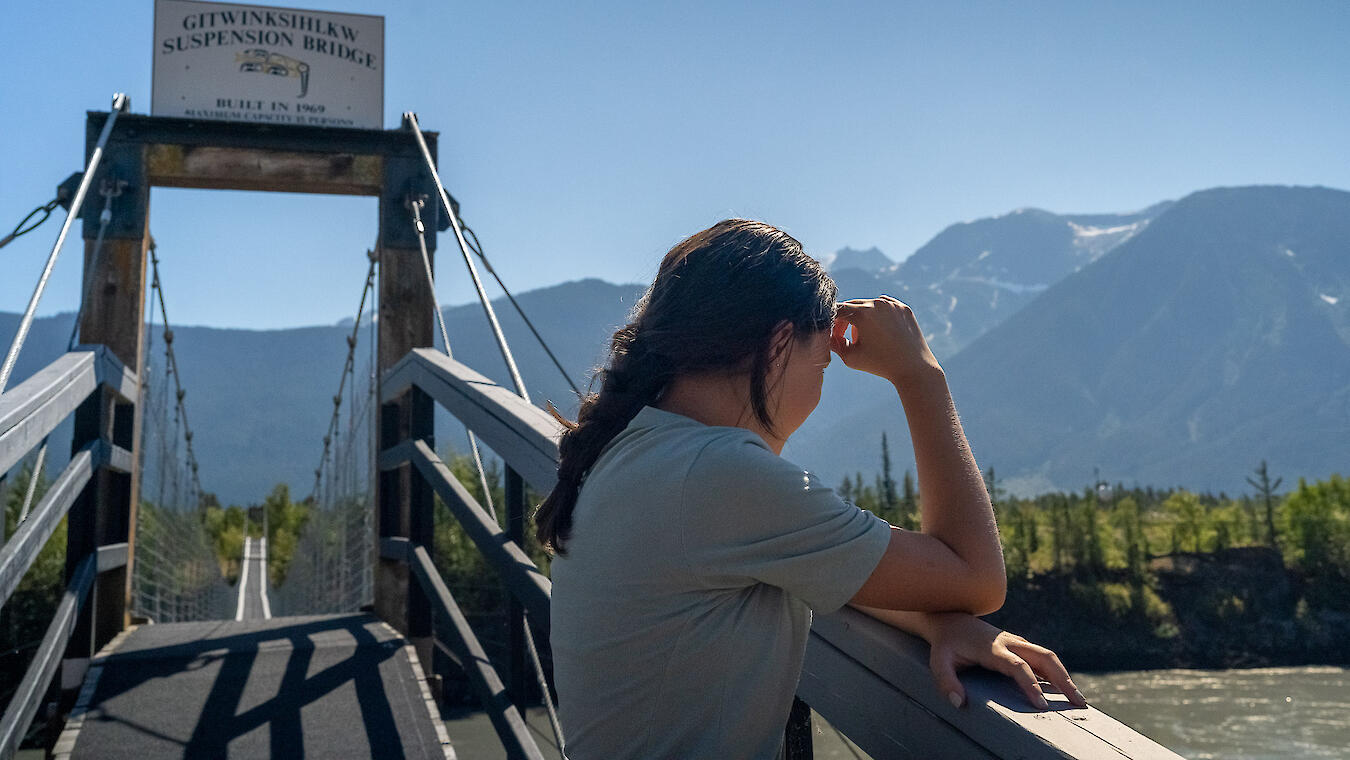
Connection through Recreation: How Trail Networks in Indigenous Communities are Garnering the Attention of New Allies
No sounds of city life are to be found here. The rushing water pounding over lava rock and through cedar forest reverberates throughout the air. It’s the type of place where as soon as you step out of your vehicle, you feel a sense of peace. There are no crowds to fend off, no places to be. Just you and your natural surroundings. The flora is relatively young, a volcano swept through here a mere 300 years ago, drastically changing the landscape and devastating the Nisga’a who made it their home.
I stumbled upon this place by accident last year, in search of epic bike trails while travelling in Northern BC with my family. It made me wonder what impact the trails being crafted by various Indigenous communities were having on the broader biking community. When I was preparing for this piece I was told that “the average non-Indigenous person will not step foot on a reserve in their lifetime.” But here we are.
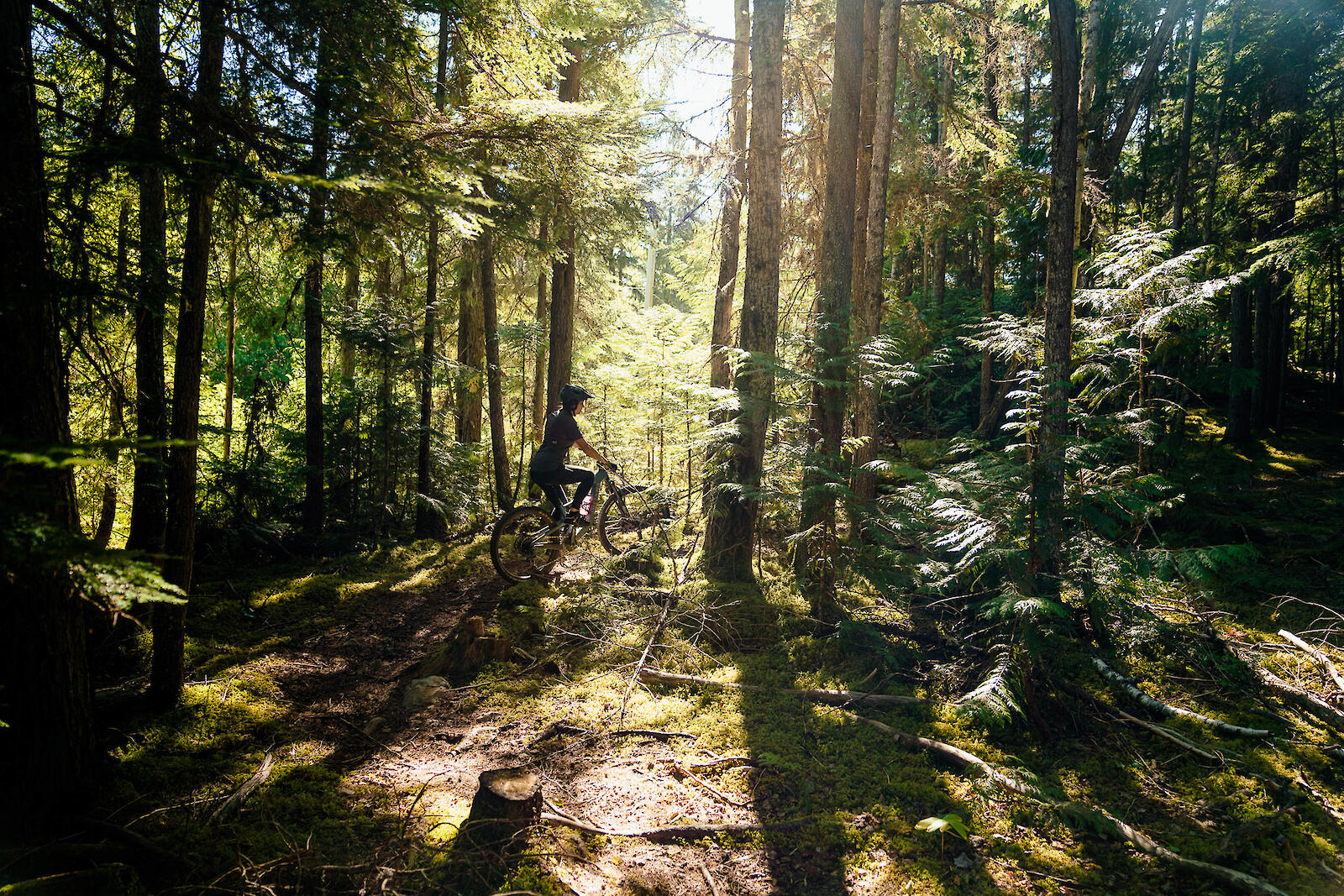
Bike culture is often displayed as “ride hard, high adrenaline,” but when it comes down to it, the thing that stands out to me about biking is community. At any race, film set, or workshop, you will always find a large group of people cheering each other on. Whether you have met before or not, when you meet someone on a bike you form an instant bond.
There is a whole other side to biking that doesn’t grace the front pages of magazines. It’s a slower pace, where moments are spent in quiet contemplation. It’s about fully absorbing your surroundings and creating a deeper connection to the land. For a couple of weeks my husband, Kyle, 11 year old daughter, Gaia, and I traveled around BC visiting reserves and various Indigenous communities with no expectations, just curiosity, and our bikes.
Stswecem'c Xgat'tem First Nation/ Big Bar Ranch
Canoe Creek Band and Dog Creek Band
Our first stop is Big Bar Ranch which is managed by the Stswecem’c Xgat’tem First Nation. Since we arrive after office hours, we are greeted with a welcome note on the lobby door directing us to our room. A thunderstorm booms throughout the atmosphere. Being from the Rockies, it’s not often we get unobstructed views of lightning. Gaia enjoys sitting on the front porch of our room watching the sporadic flashes of energy while we settle in.
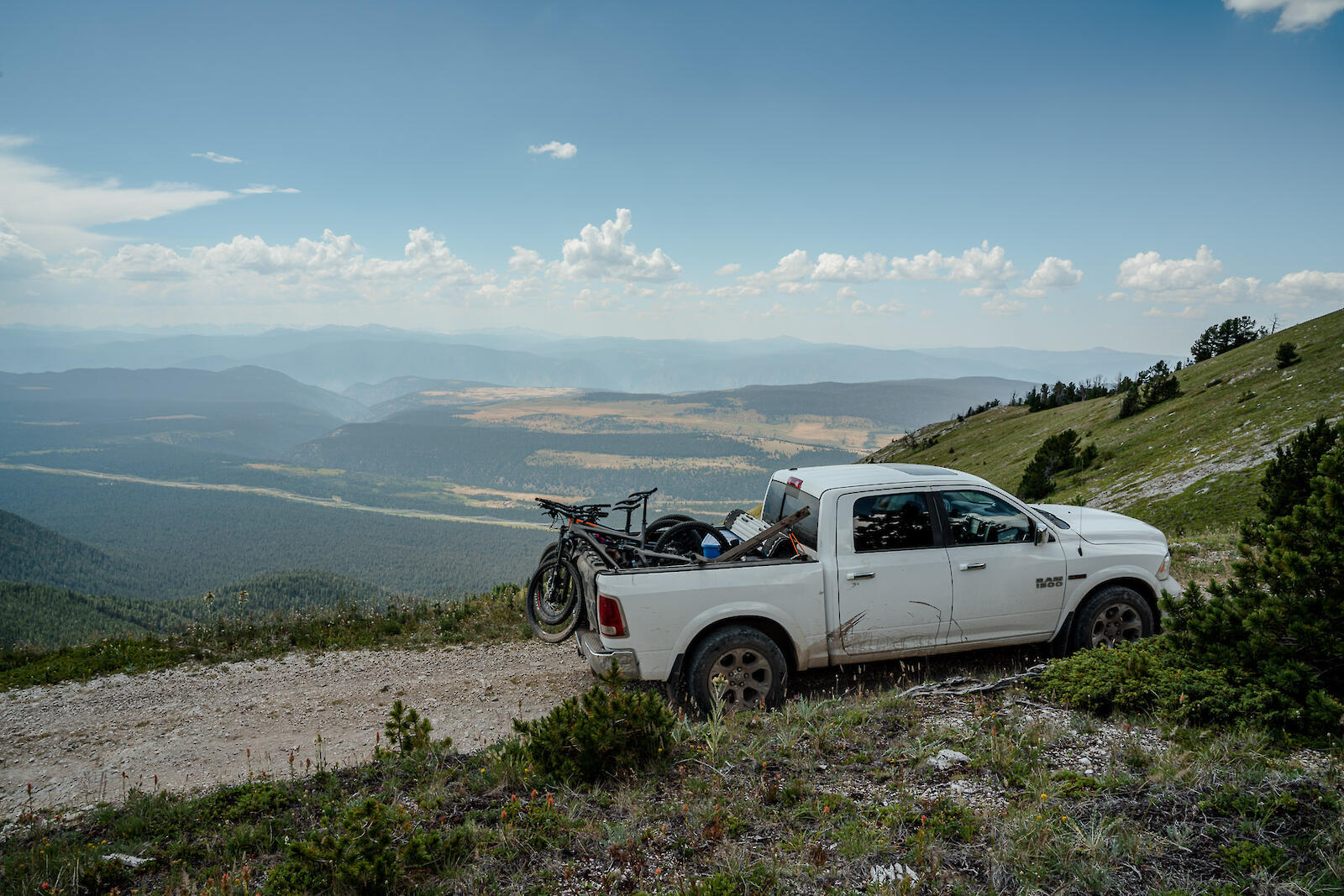
Jesmond Mountain towers over the valley. The riding area consists of two trails- Stairway to Heaven & Lost Marbles. They are true blue and true black hand-cut trails. It’s a wonder how the workers got into this remote area to carve out such complex trails.
750 metres of elevation loss over 3 km is something else. To be honest, just the drive up Jesmond mountain is terrifying enough, I have no idea what we're getting into as far as the actual riding goes. The road is better suited for an off-road ready vehicle than our 1/2 tonne truck, but despite the hair-raising mission to get to the top, the views alone are worth it.
Upon arrival, we realize that we have to re-evaluate our decision to ride Lost Marbles, a steep loose black diamond trail, far different from the terrain we are used to. Since we are in such a remote area there is no room for error. We take our time analyzing the weather and contemplating the blue 2-way trail with less elevation loss over a greater distance.
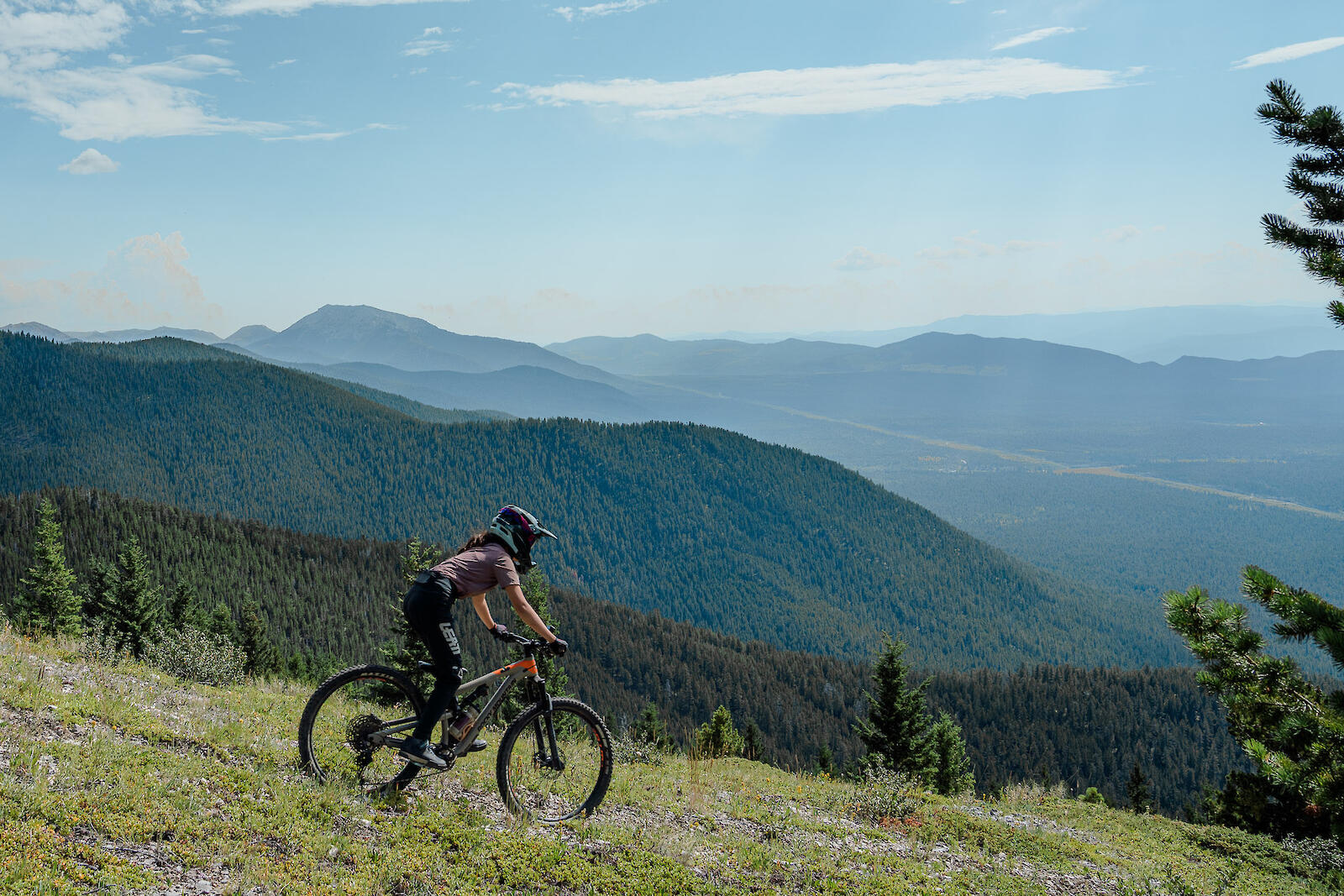
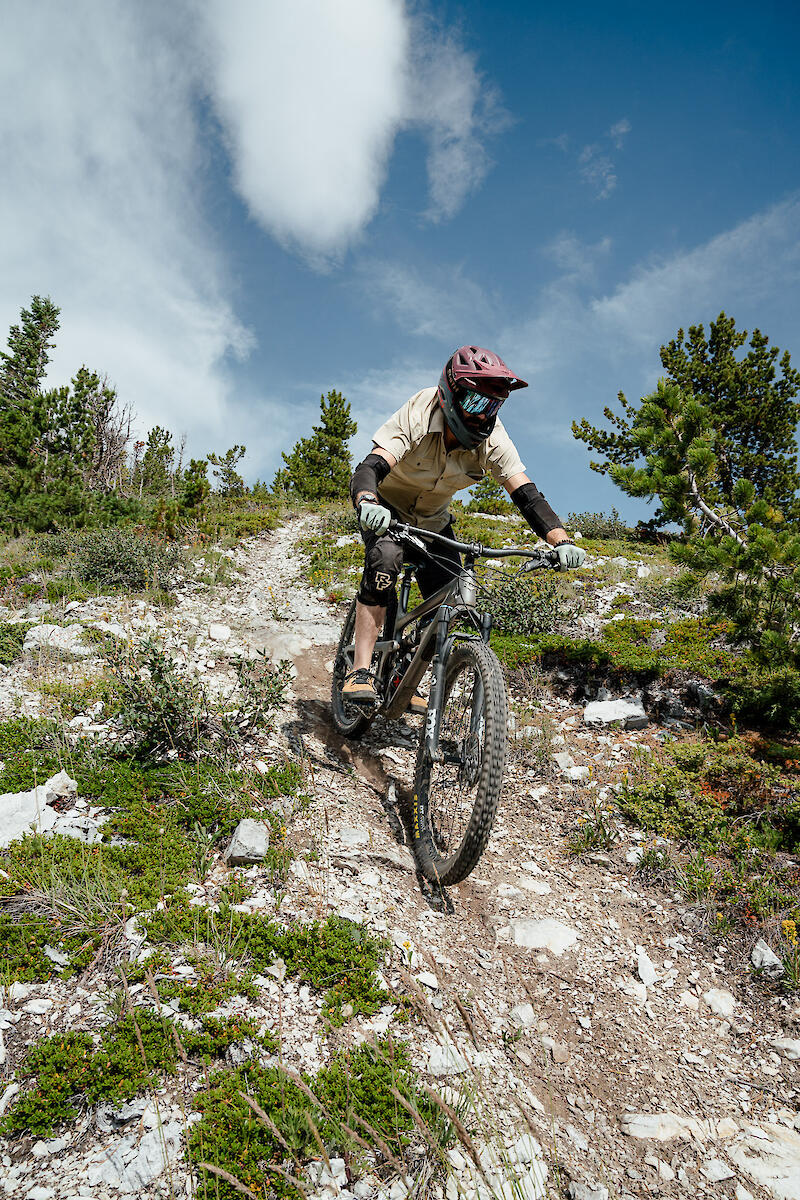
In the end, we stick to our original plan of riding Lost Marbles. The beginning starts with absolutely stunning views of the valley below and an open alpine descent. Once we cut into the trees, there are some steep sections and a couple of decent sized natural drops. The trail would probably be incredibly quick if I wasn’t stopping to look at features, take photos, walk sections, and the ever-necessary- giving our braking fingers a rest.
Back at the ranch, we wander around the dining hall, taking in photos depicting the rich history of the land and the Indigenous people who grace it. A quick game of horseshoes and a sunset walk with the free-roaming animals take up the rest of the evening.
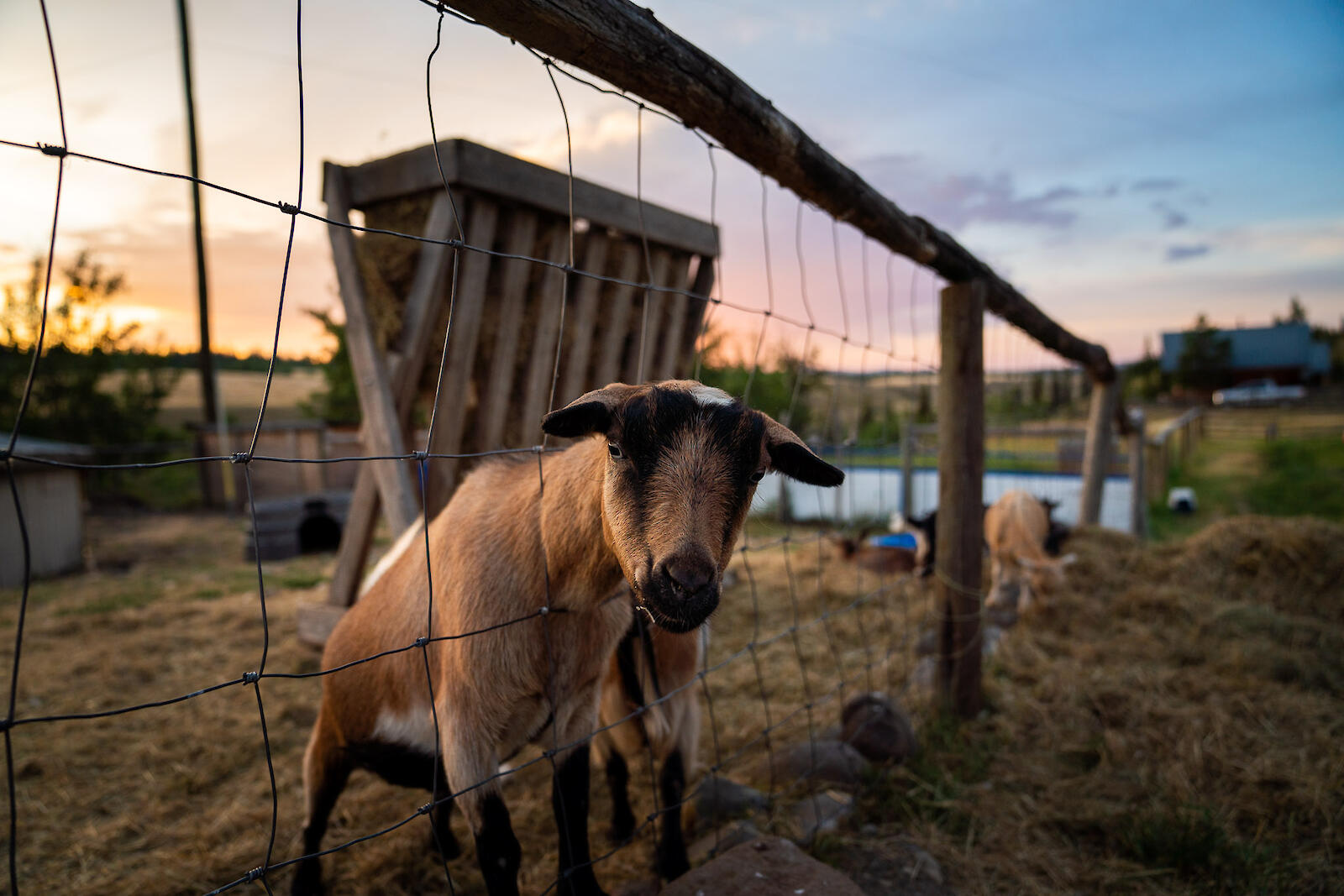
In the morning while Gaia and I wait to explore by horseback we chat with a few of the other families. Only one of the ranch hands has ridden the bike trails, and he also describes it as an exhilarating ride, although he gravitates towards different descriptive words.
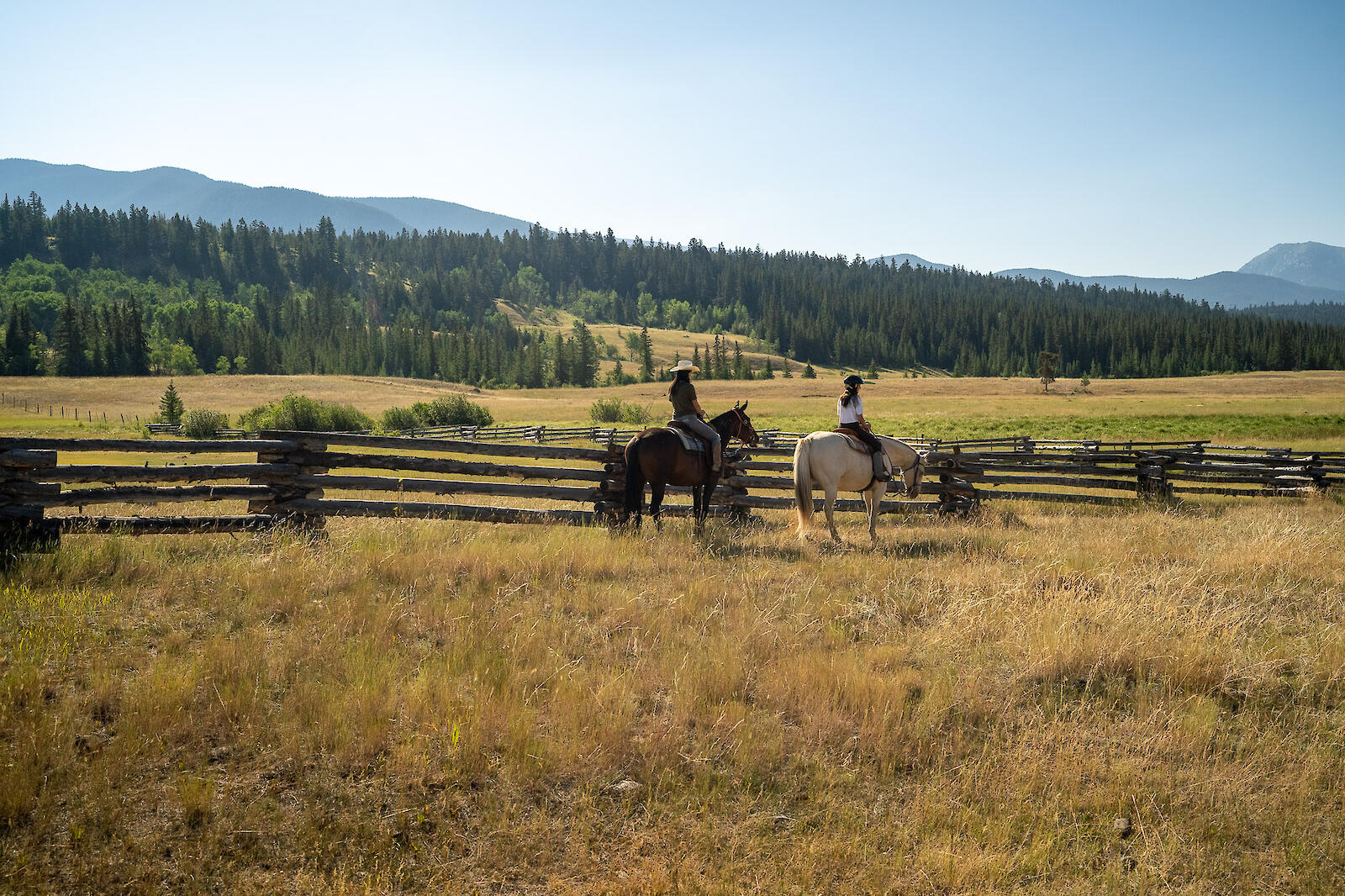
As our horses climb up over the ridge I soften into the saddle, in an attempt to relax. Riding an animal is such a foreign feeling for me. I’m far more comfortable on 2 wheels. Our wrangler confidently maneuvers us through a gully and guides us back to the ranch. When we breach the forest and see the “Welcome” sign again, my stomach flips with excitement. Soon I’ll be back on my feet, my well-being no longer entrusted to this gentle giant. We make it back to the ranch in one piece and Gaia and I both dismount. I laugh as my legs nearly buckle. Gaia waddles off in a similar fashion and soon we are both laughing. We are quickly reminded how stiff your legs get after 2 hours of straddling a horse.
Tsq’escenemc/ Secwepemc/ Canim Lake
Standing rock
We pull up to Canim Lake Resort in perfect weather. The hot summer sun beats down on us as we set up camp on the lush grass. While the lake is fantastic for boating and fishing, the warm temperatures make it a breeding ground for plant biodiversity so instead of swimming, we laze around camp waiting for the temperatures to drop.
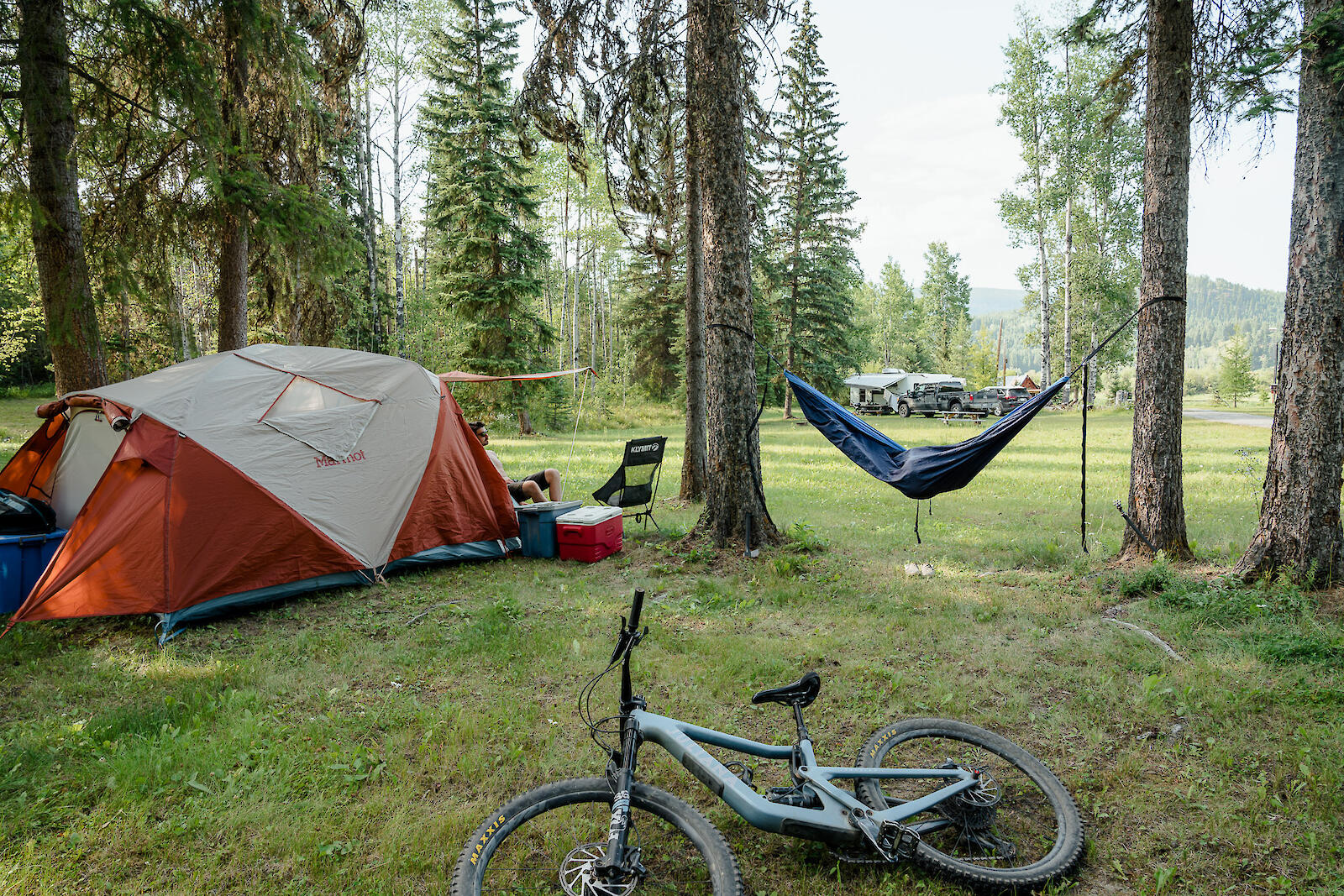
As the sun sinks below the treeline, we pack up the bikes and drive to the trailhead. Unfortunately, a side effect of the cool evening temperatures is that the bugs come out. Mosquitos swarm us, enticing us to get a move on. At the trailhead, we find the DH trail to be overgrown but definitely still distinguishable. Despite being in an arid area, the trail follows along a gorgeous creek and the sounds of rushing water follows us down the trail. The cool light of dusk filters through the forest and the overgrowth makes it feel like we’re picking a line in the forest.
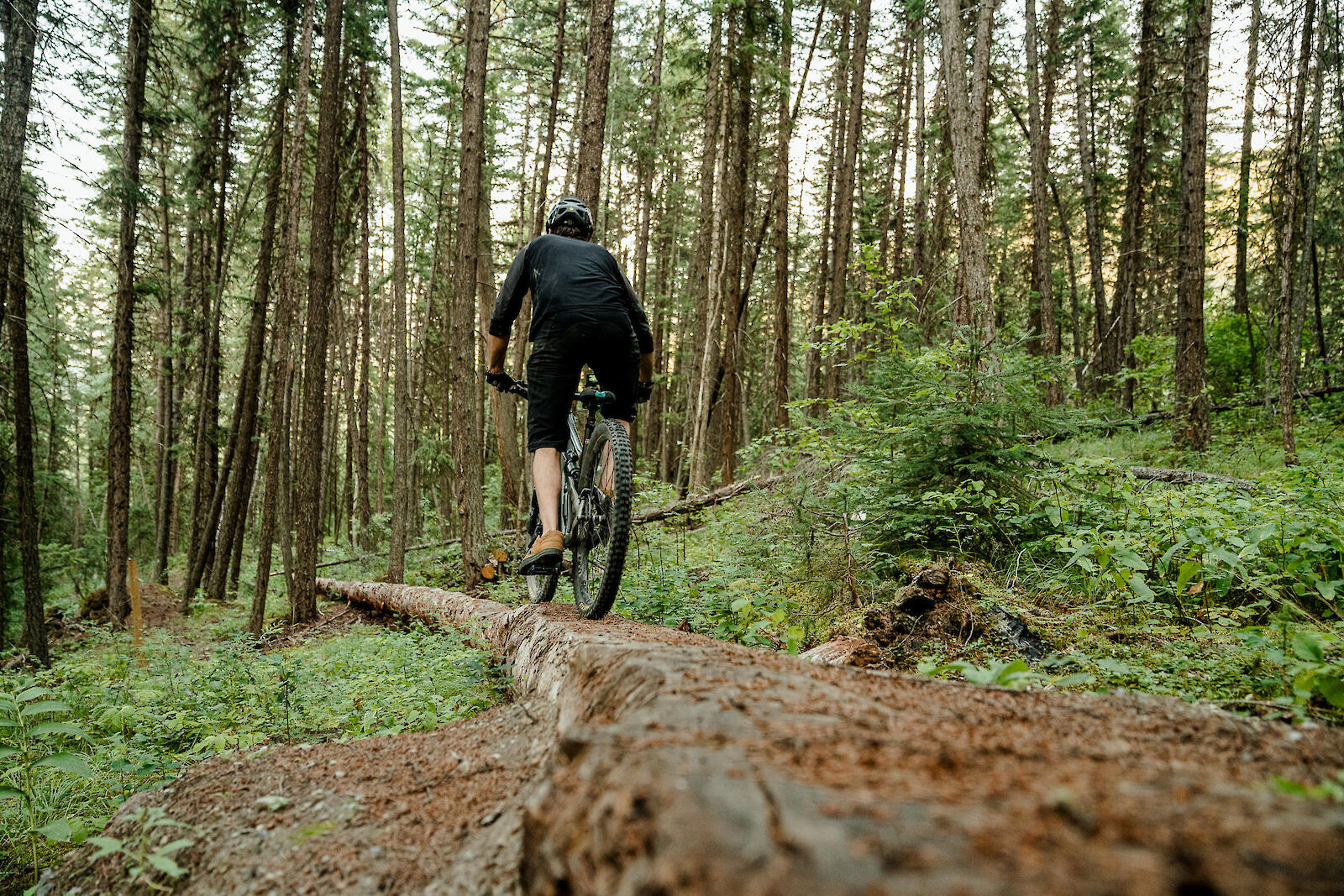
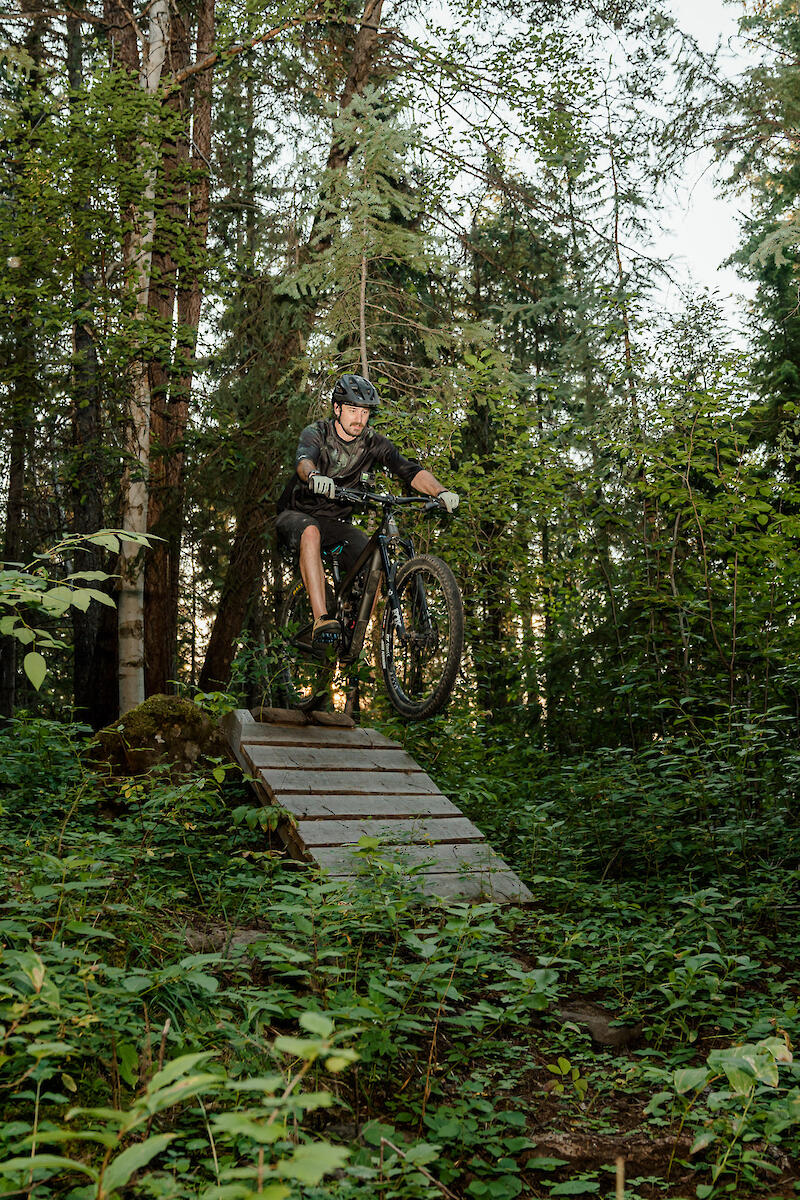
While we wait for Kyle to retrieve the truck, Gaia and I decide to make a quick trip up to the viewpoint. This trail was originally created to connect the two sides of the community together providing a safe path for locals. Wildflowers creep onto the path, reminding me how quickly nature can reclaim the land.
Xatśūll First Nation/Soda Creek
On the Cliff Where Bubbling water comes out
We loved riding in Williams Lake and were thoroughly excited to visit the trails on the Xatśūll lands.
Just below the highway, down a winding road to a ravine sits the Xatśūll Heritage Village. Originally, in a vigorous attempt for a “full cultural experience”, we booked a teepee to sleep in. Upon arrival, we realize that teepees are not fully sealed and our pampered lifestyle doesn’t lend itself to being a bug smorgasbord. With minimal regret, we opt to camp in our fully sealed tent instead. As we set up camp we are informed that teepees are not traditional to this area and that the Xatsull First Nation dug partially into the Earth to create pit houses that could last many years.
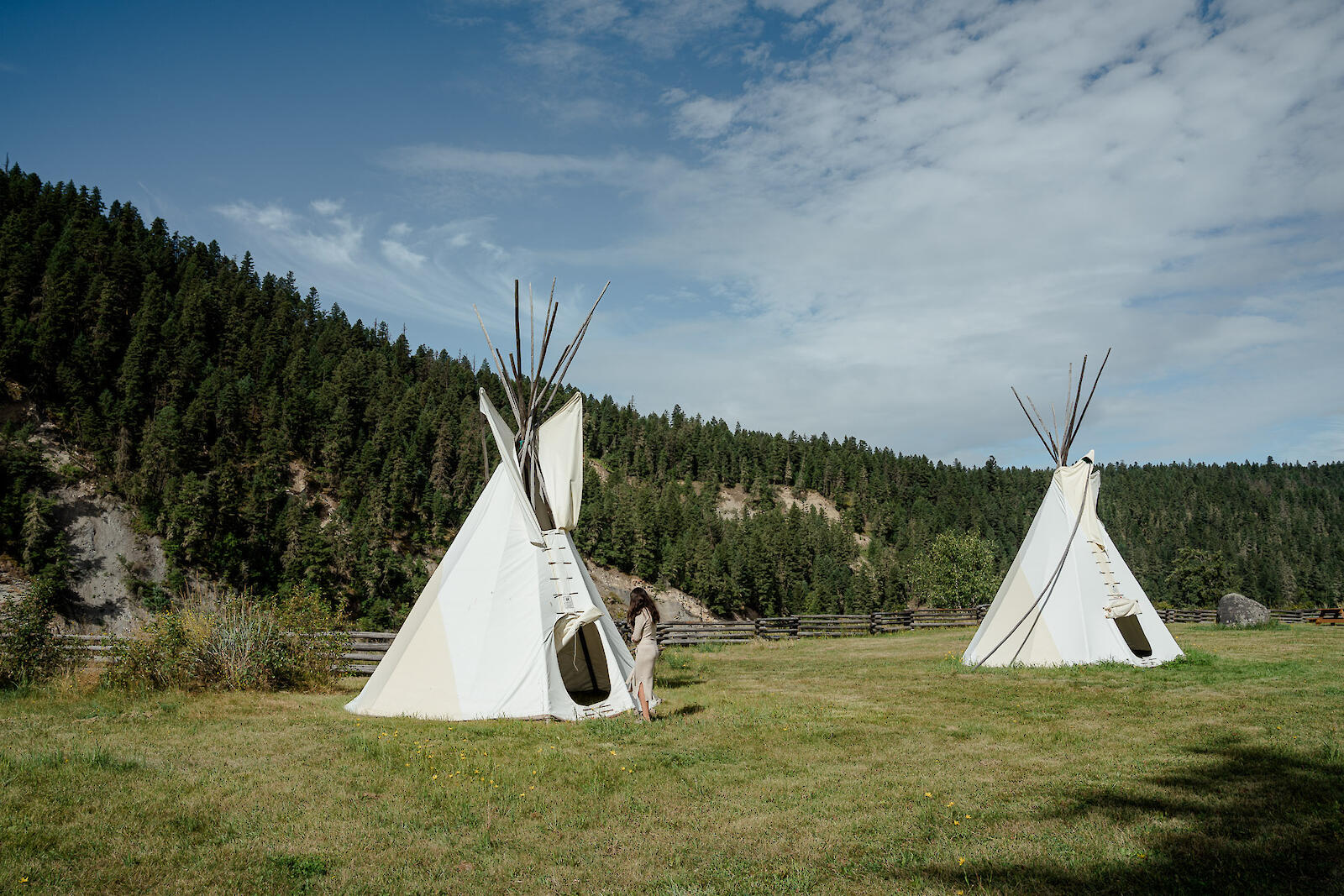
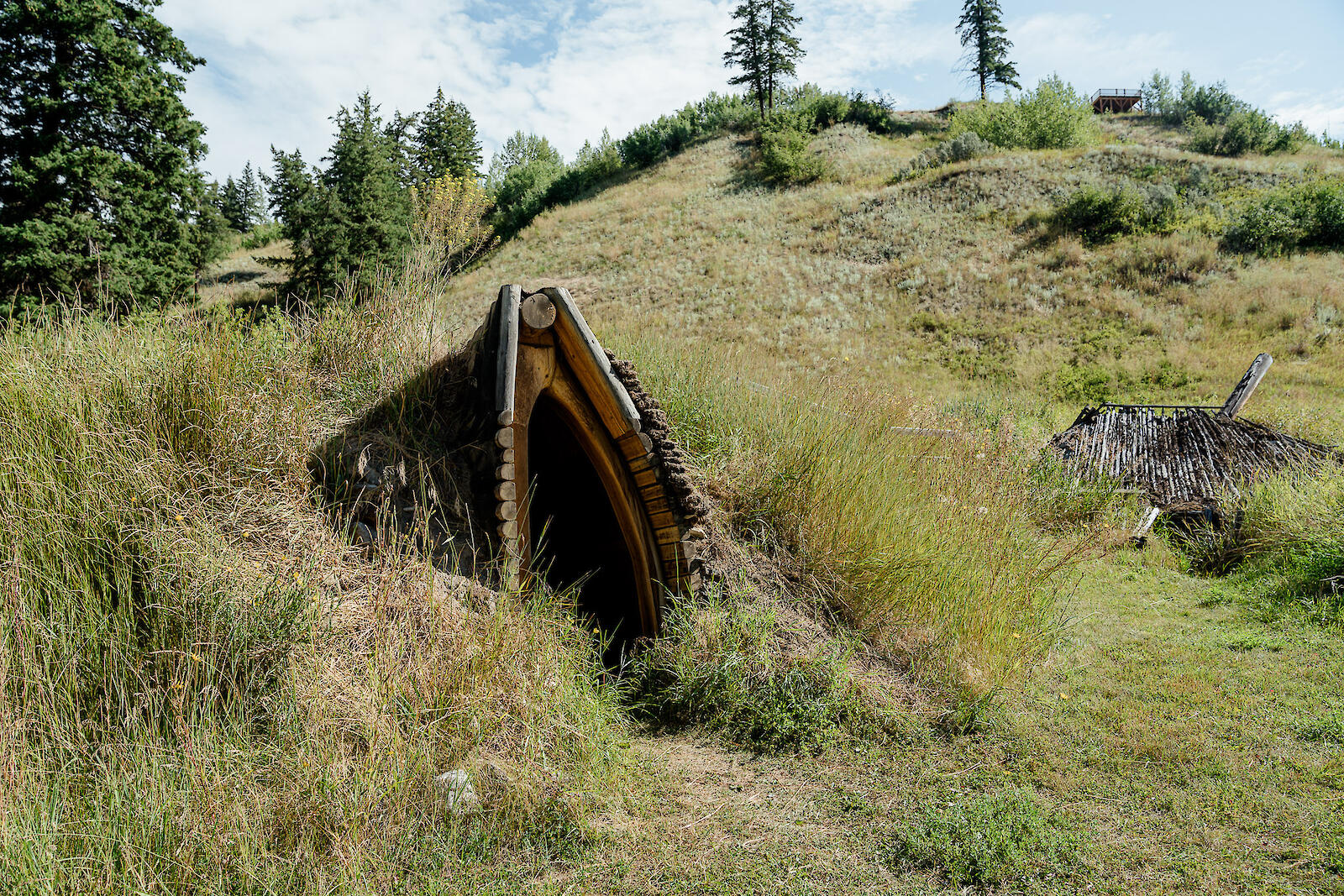
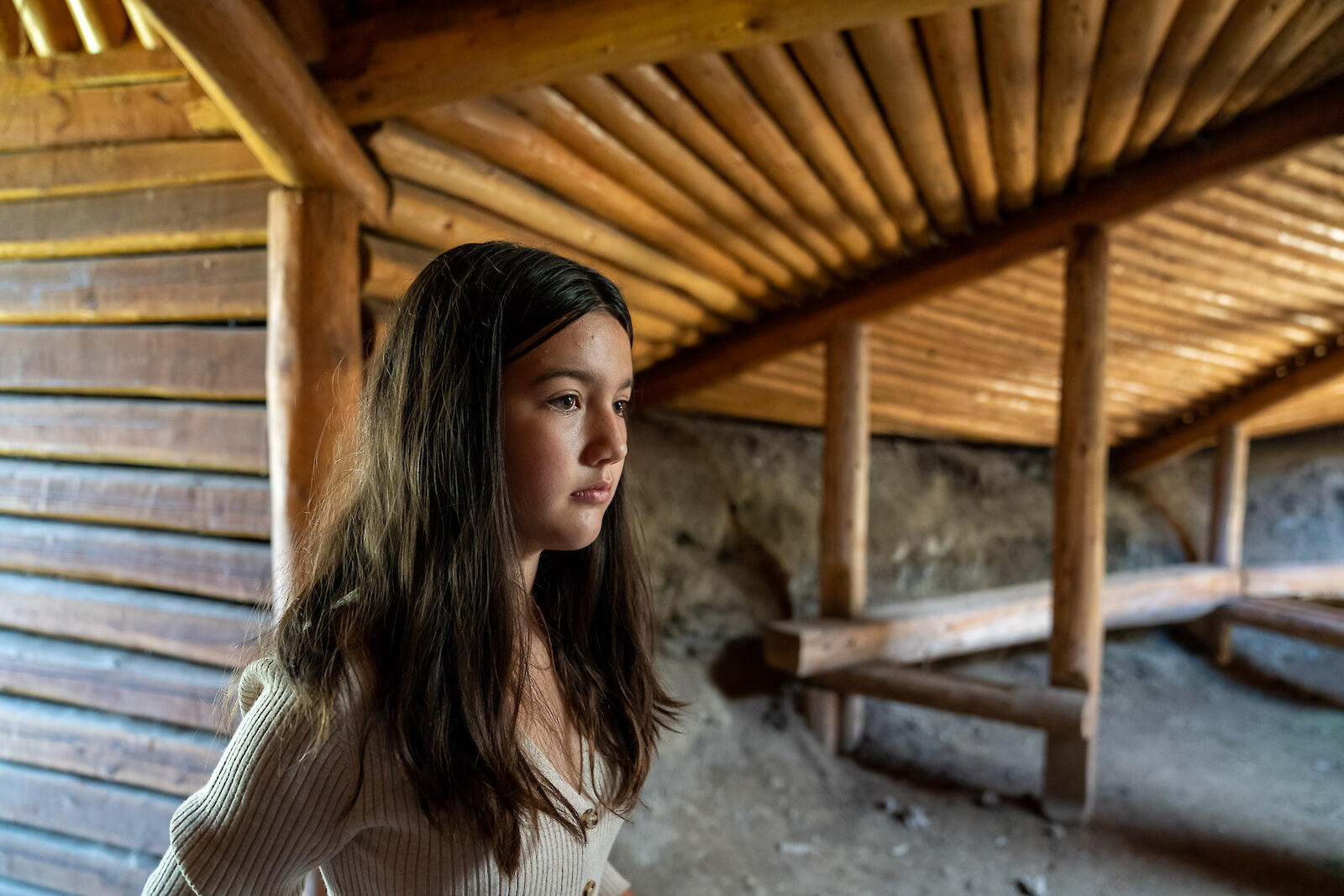
We drive back up the road and cross the highway to the Xat’sull trail network. There are a few shuttle accessible trails and at the top sits a massive 17 km cross-country ride. DH Hipsta, a blue downhill, is our trail of choice. We’ve seen so many images of the stunning wood feature overlooking the valley, we can’t wait to ride it.
As we start to unload our bikes a truck with a couple of cruiser bikes in the box pulls up beside us. The gentleman asks us how long we thought it would take to ride the trail. We inform him that it’s our first time so we aren’t sure, and he says, “living here, I take all of this for granted.” As someone who had just travelled several hundred kilometres to ride this trail, I just laugh and agree- we all tend to take the treasures close to home for granted.
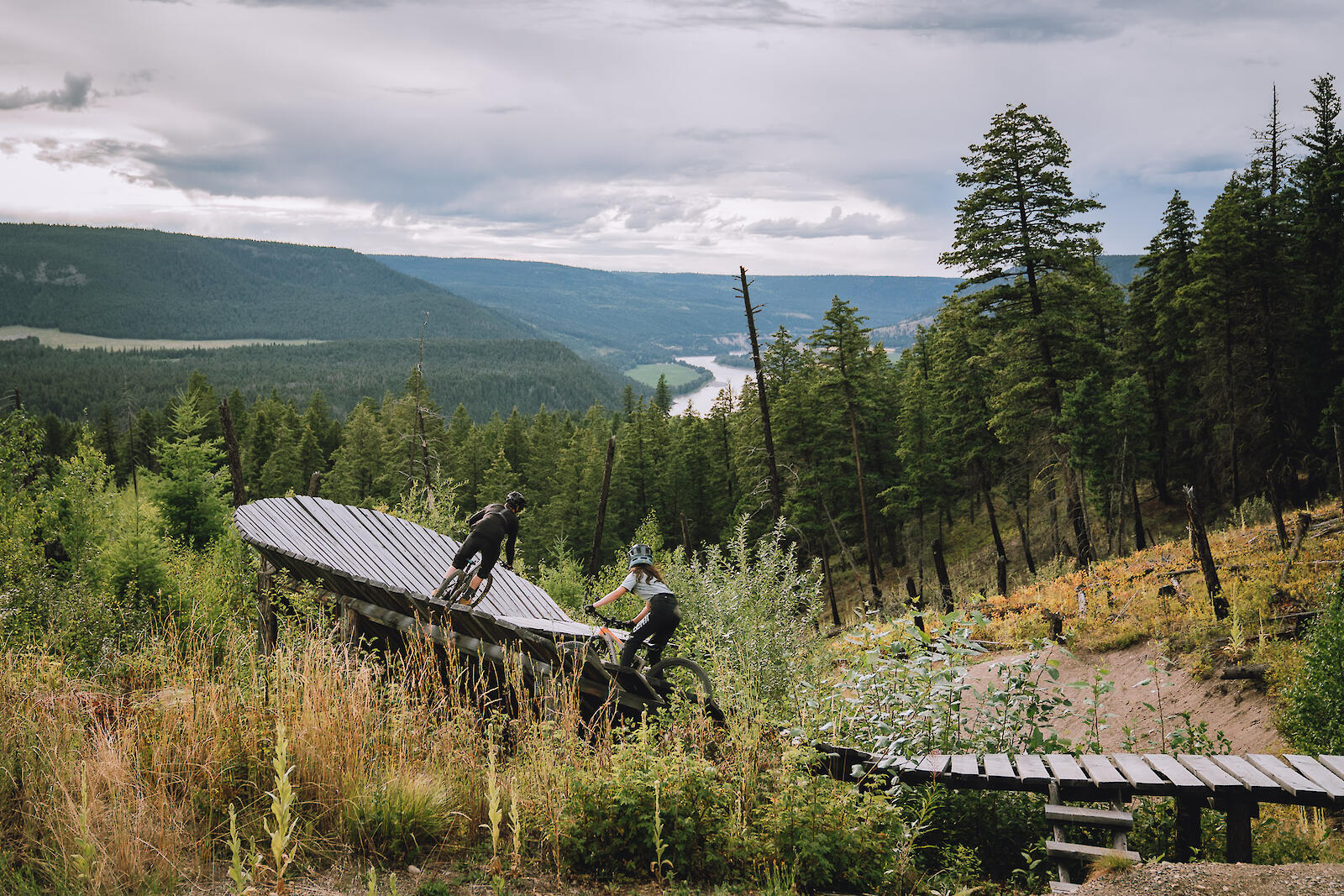
This summer, Gaia came into a couple of drops a little too hot and it’s made her somewhat hesitant when it comes to big air. As we ride up to the large wooden feature, she eyes it up a few times and follows her dad in before giving it a go. She lets out a little squeal of excitement and heads back up to land it perfectly 3 times. I decide there are few things more feel-good than the stoke of someone accomplishing a technical feature for the first time. Dirt flies as we cruise down to the road gap and end of the trail. Kyle decides to pass on the gap- pre-ride before you freeride. On the second lap, he gives it a go, but with no forewarning, I don’t have enough time to pull out my camera. If there’s no photographic evidence, did it even happen?
Light fills our tent by 7am. Opening the fly we spot a pair of eagles soaring above, calling out, waiting for the perfect moment to snatch a tasty salmon from the river below. Roxanne, a member of the Xatśūll First Nation, pulls up for our morning workshop. After a brief introduction, she sits across from Gaia and they begin the intricate art of crafting a dreamcatcher. As Roxanne instructs Gaia, weaving the string from side to side, she also shares stories of her personal journey to reclaim her culture.
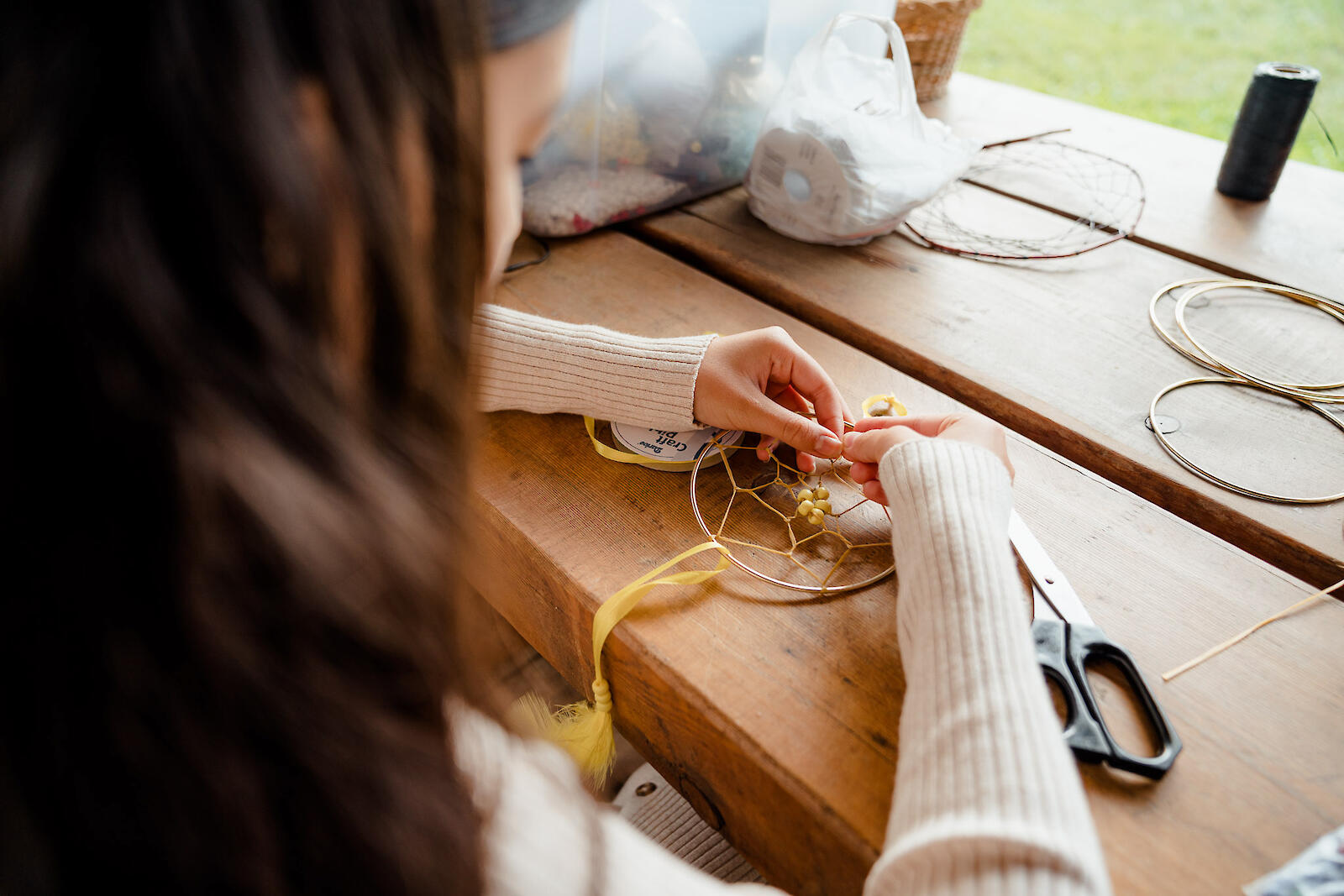
Hazelton/Gitxsan
People of the River Mist
Darkness is beginning to take hold by the time we pull up to Hazelton, but since we have booked an Airbnb, we don’t have to worry about setting up camp. Access to town is over an amazing single lane bridge. Looking over the railing into the spectacular ravine is mystifying. Just past the bridge, the trees open up to a stunning view of Hagwilget Peak- an ominous looking mountain standing watch over the valley.
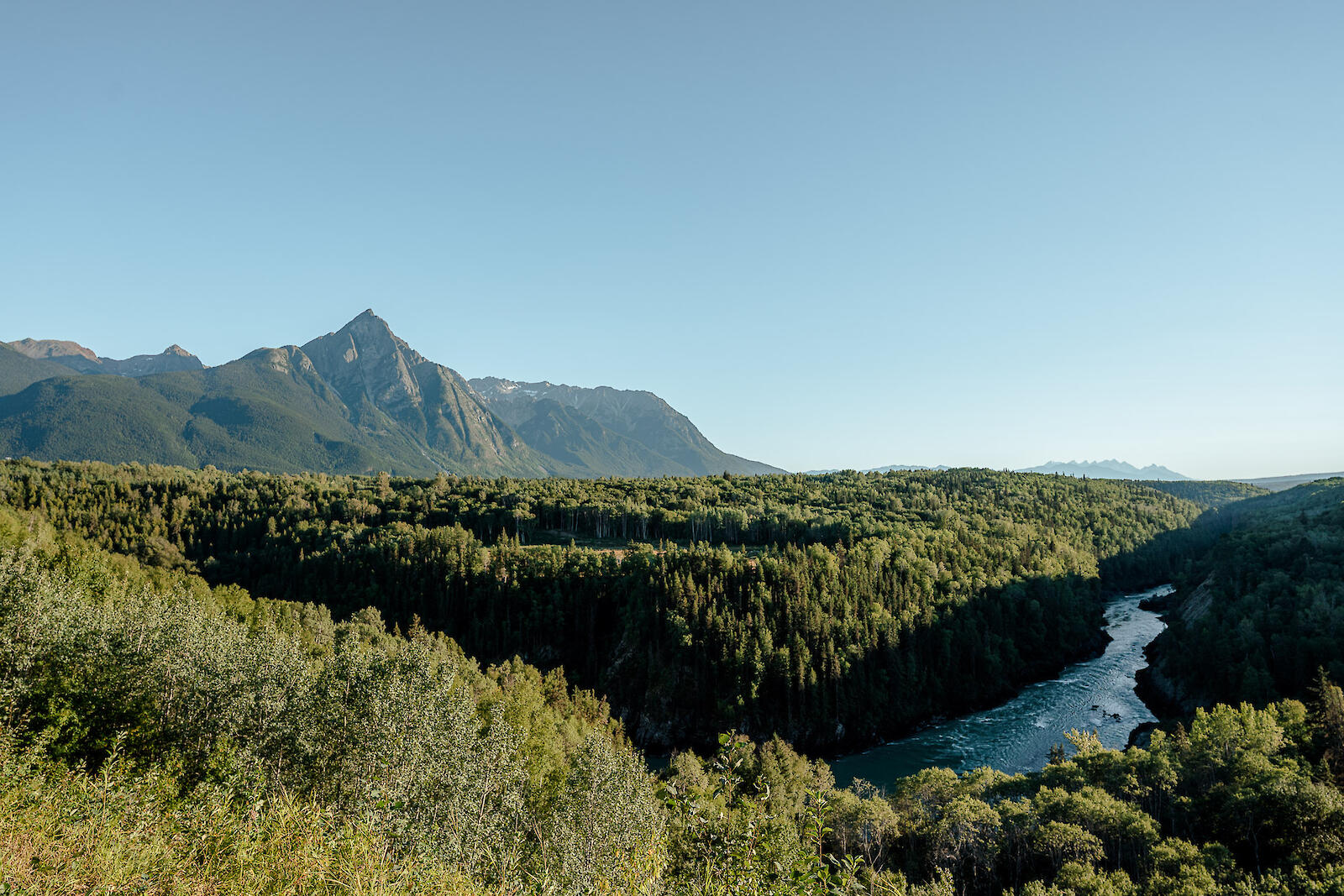
The morning brings another round of warm weather, and as usual, we are slow to get out the door. The Hazelton trail network consists of 11 trails, all concentrated in one area. It’s difficult to choose one as the images on Trailforks have me thirsting to ride them all. Driving up the mountain we are delighted to see that the trails open up to a thick forest with lush moss. Rays of light shine through the trees, illuminating the rich carpets of green. The scene is reminiscent of a fairytale, and I half expect a magical creature to appear out of the corner of my eye.
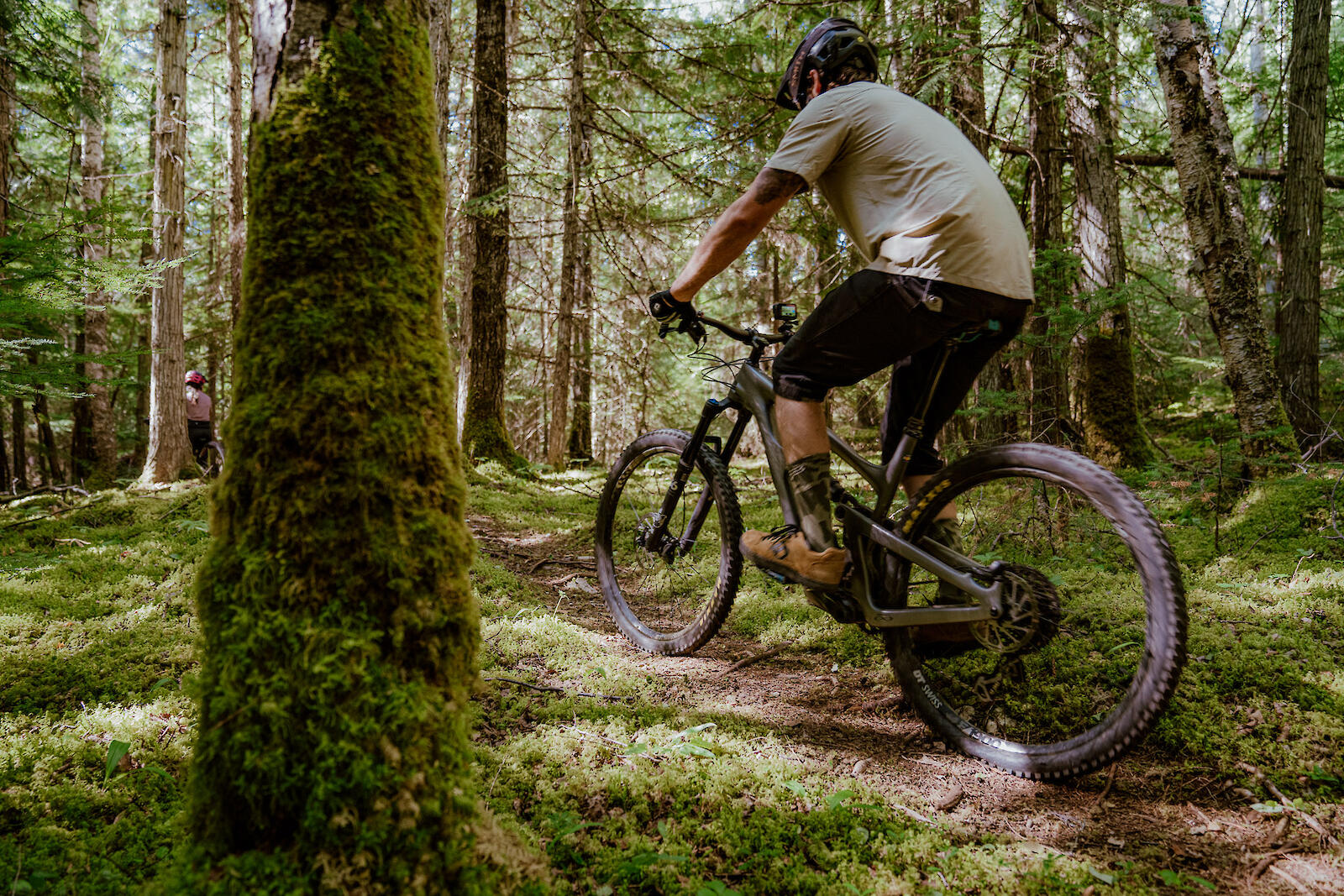
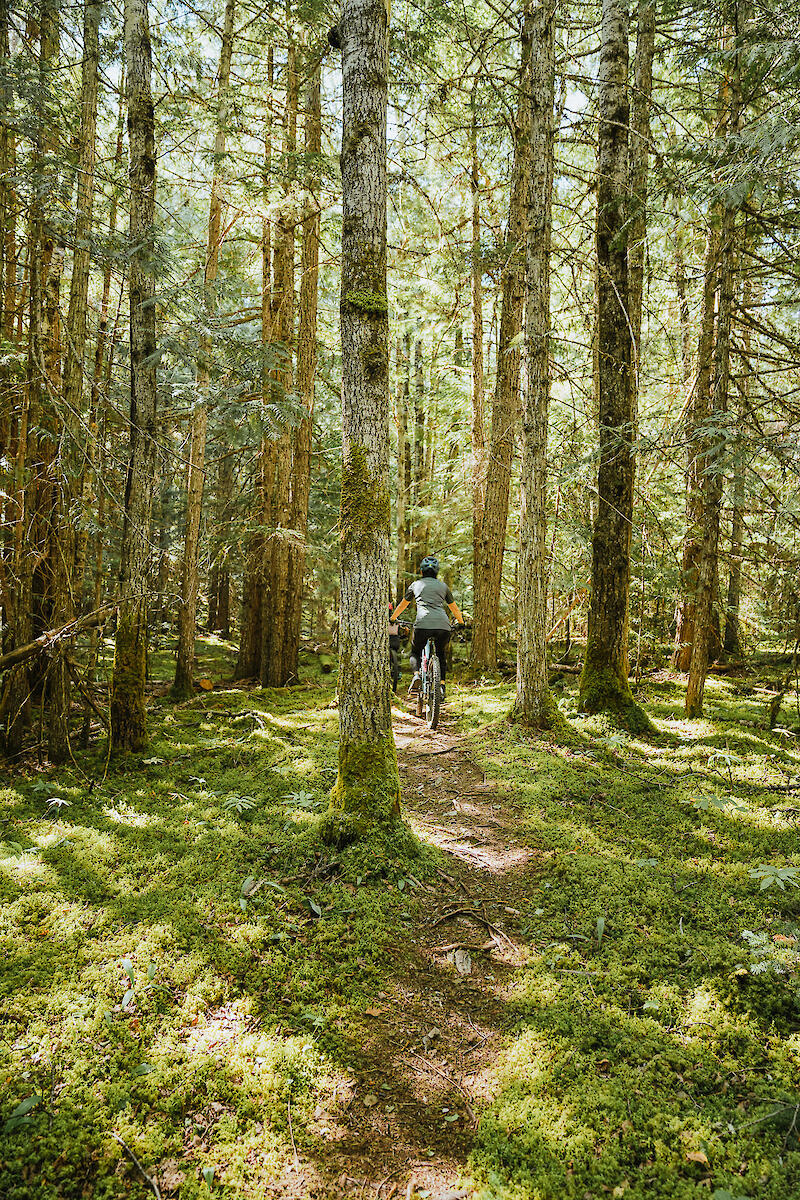
Although Laskowski starts with a bit of a climb, it is so gentle, we often don’t even realize we are ascending. That is until we reach the last section before the viewpoint. This short section leaves us breathless. The ride down from the lookout is over loose layered pointy shale, a breeding ground for a flat tire, but with the right navigation skills, we breeze through. The final cruise down Up & At’em take Gaia and I straight to town while my husband bikes back up to get the truck. The wind breezes under my helmet as we coast to town, cooling me off from the soaring midday heat.
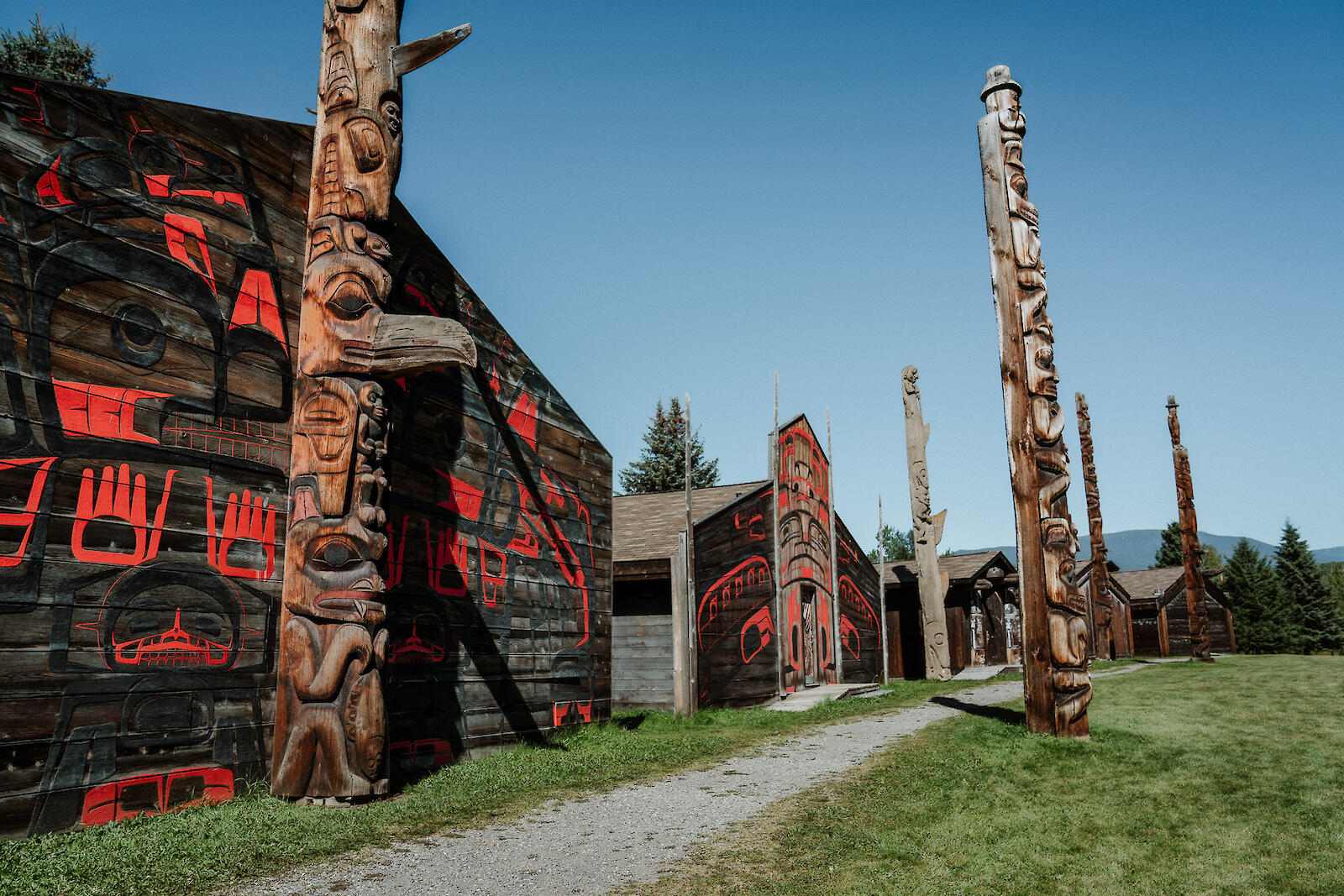
After a snack at Mercedes Beans and Model Teas, we visit Ksan Historical Village- a replica village of traditional longhouses highlighting the culture of the Gitksan people. Many of the totem poles vary in age and the village is home to over 600 items and artifacts. Sadly, the Village is facing the same staffing shortage that the rest of the country is currently facing and they are unexpectedly closed. We walk along the grass barefoot as the extreme heat beats down on us, admiring the artwork before making our way back to the a/c of the truck.
Nisga’a/ Gitwinksihlkw
People of the Nass River
The Nisga’a lands covers a vast amount of varied terrain, from ocean to lava beds, and they have taken significant steps to continue their legacy. Our first stop was surprisingly not the bike trails, but the museum.
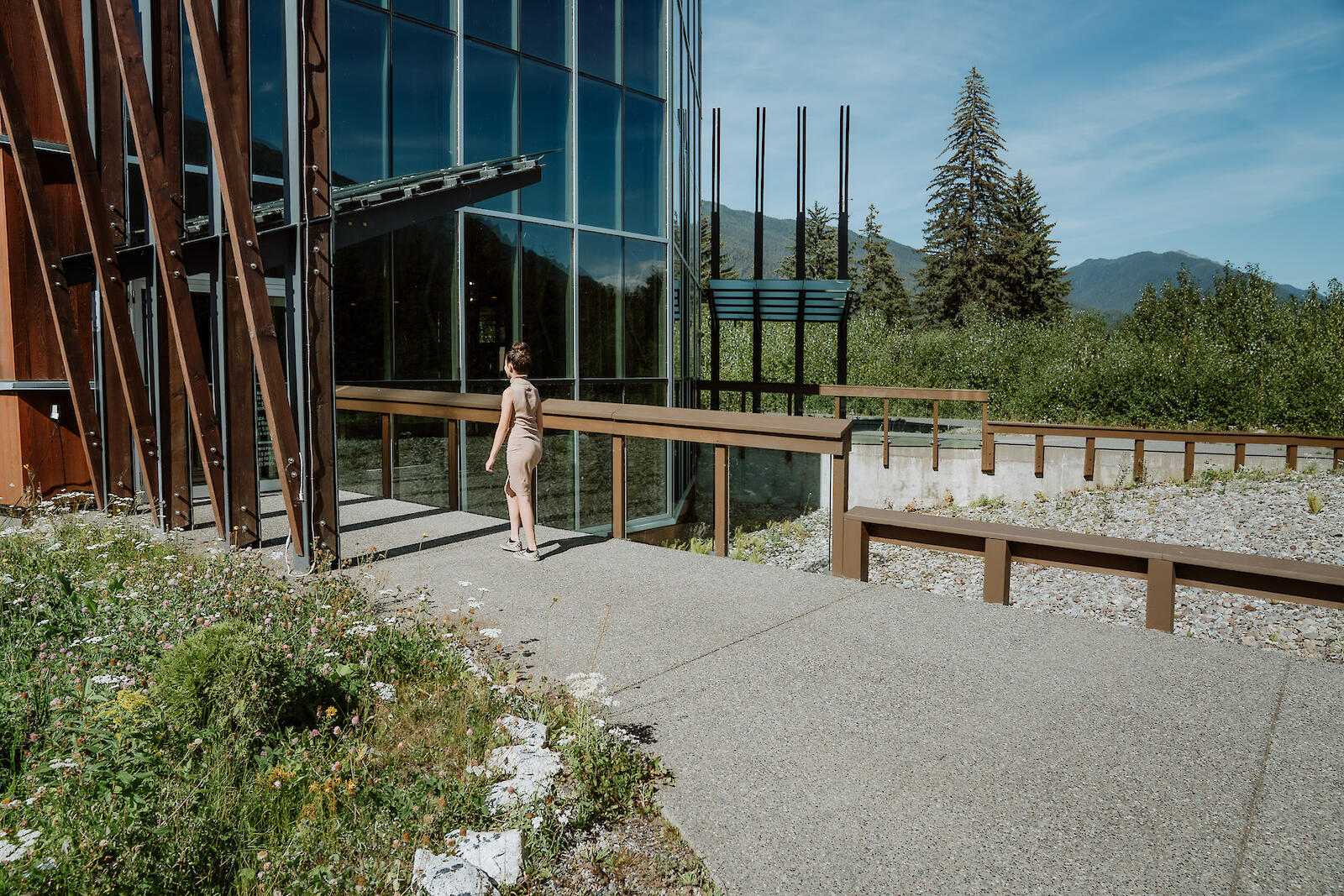
The Nisga’a museum is designed around the dimensions of a totem pole, it’s a stunning piece of modern architecture framed around a historic artifact. Staying true to their culture, the Nisga’a museum lacks the typical swaths of display boards and instead, visitors are led through the museum by a Nisga’a guide who orally shares the history.
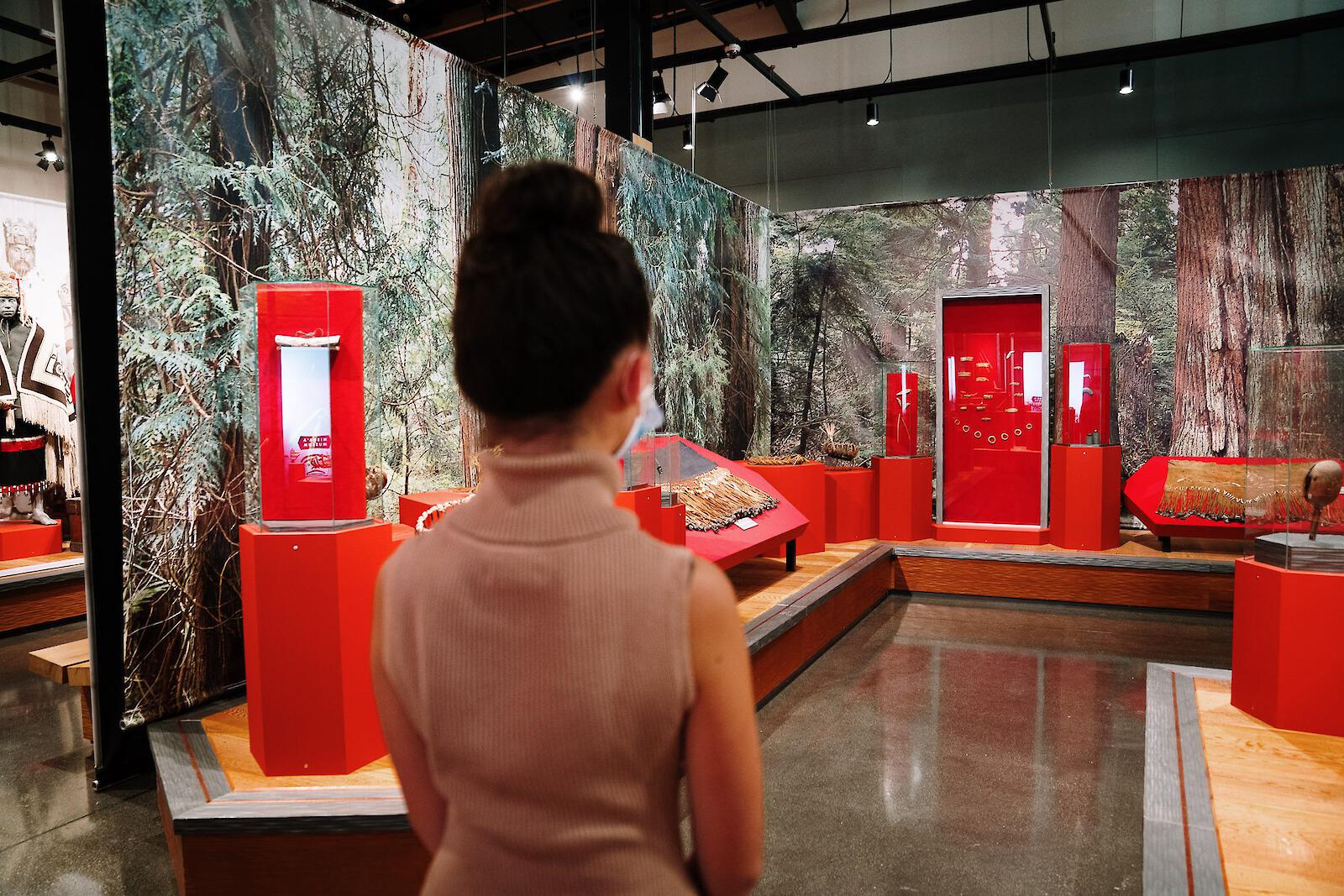
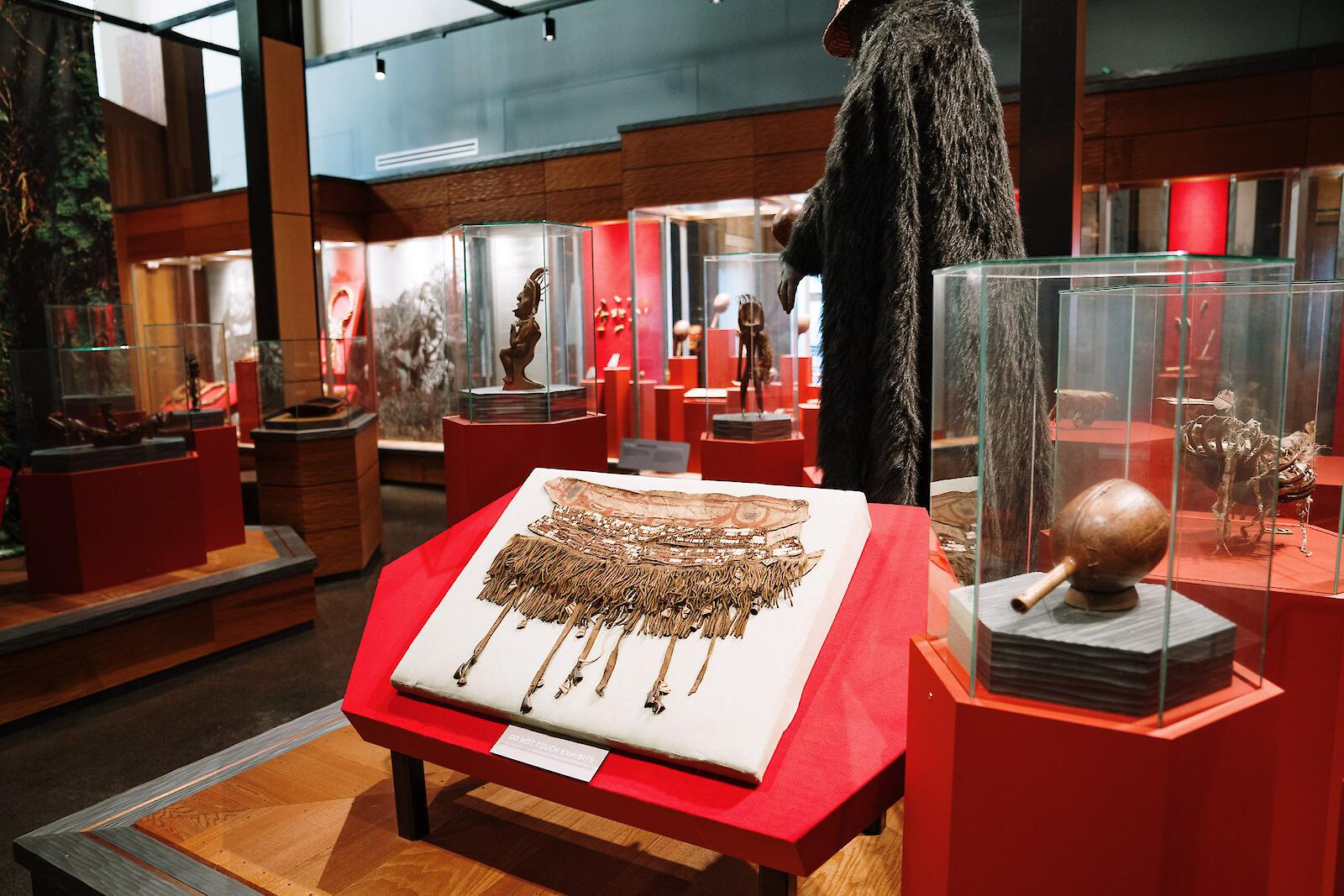
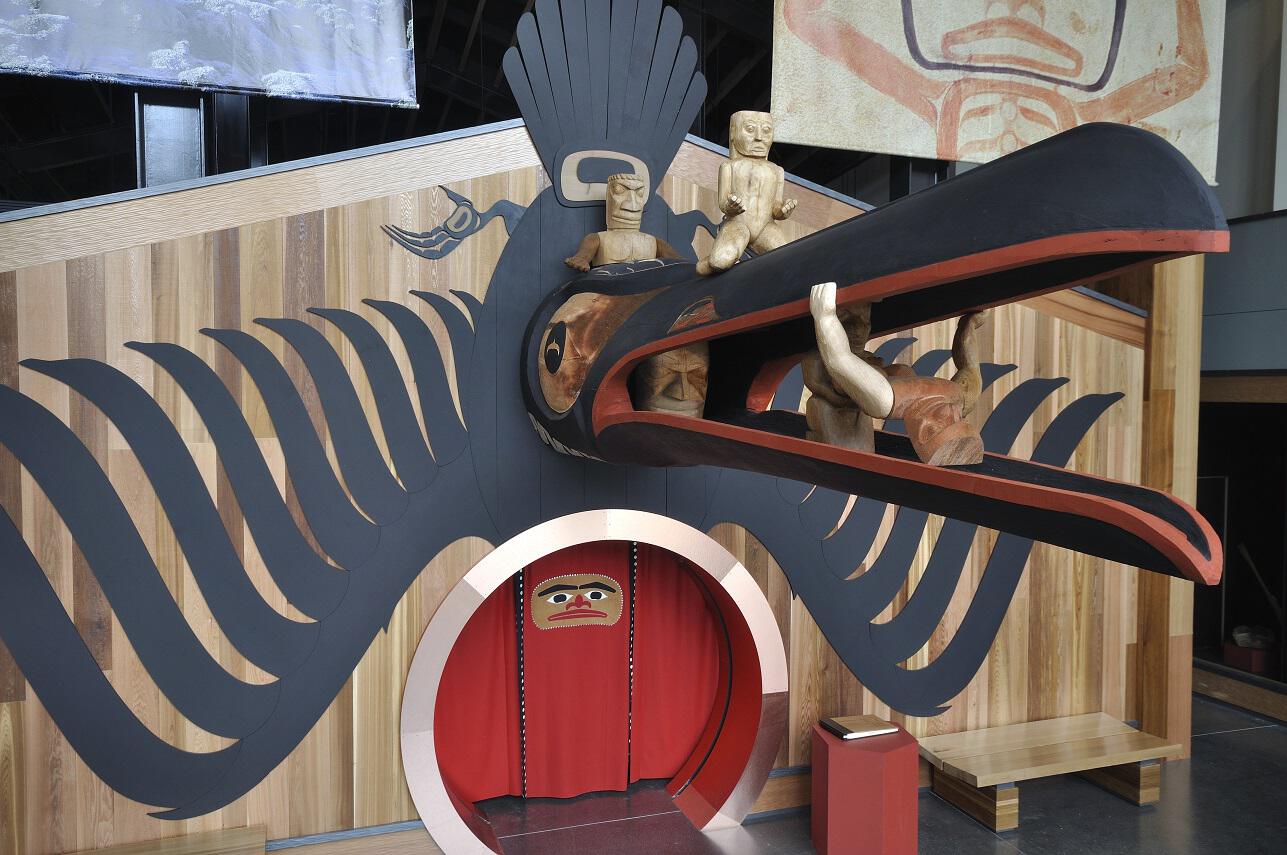
photo credit: Gary Fieghen, courtesy of Nisga’a Lisims Government
I listen to our guide, allowing myself to be transported to another time- a time before settlers had stepped foot on what is now known as Canada. The large group of tricksters donning masks incites both fear and awe in me. As our guide shares origin stories of some of the tricksters, I lean in closer. Colourful artifacts draw our attention to the next sections.
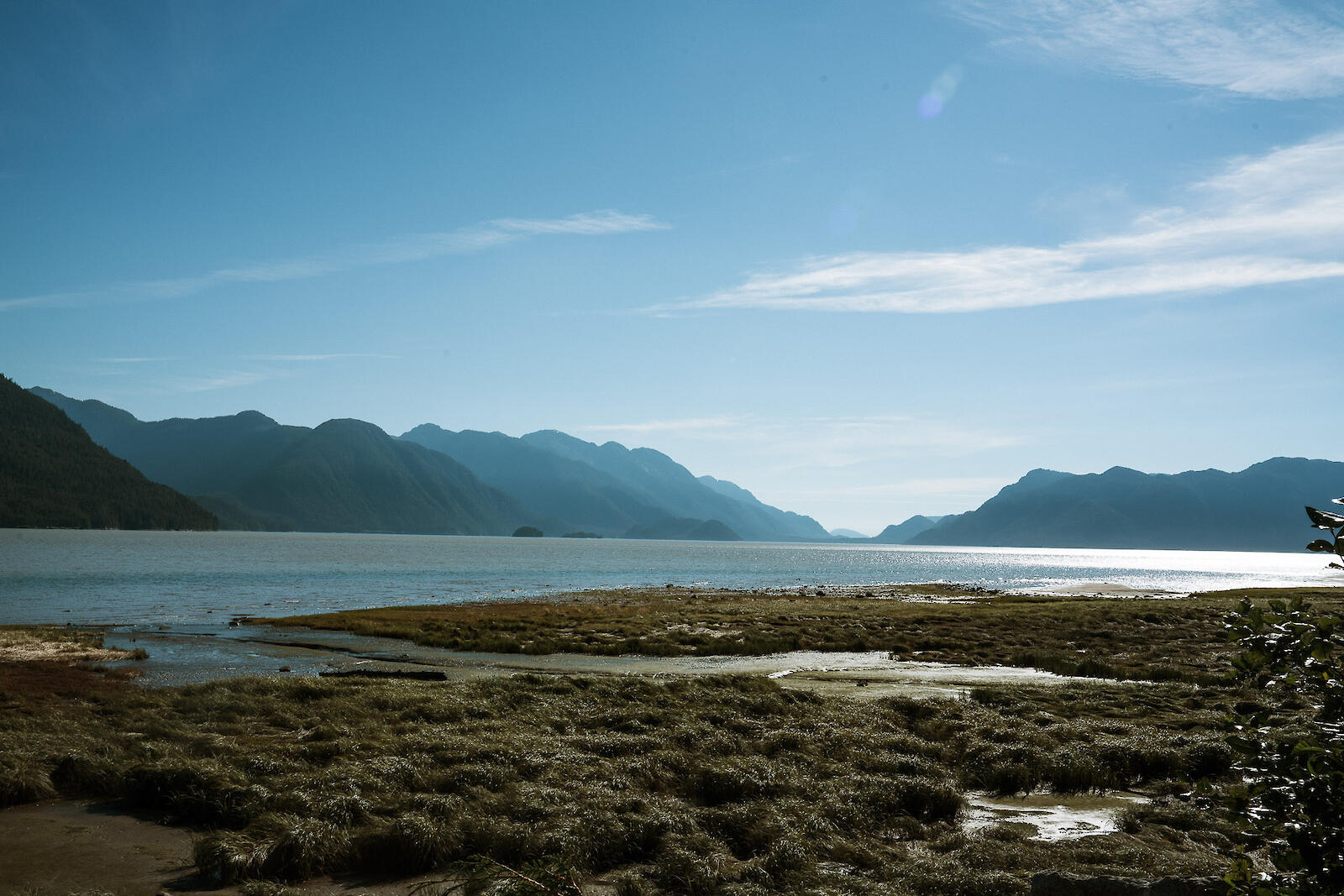
After the museum, Gaia begs us to take her back to the fish & chips restaurant, “U Seefood U Eat it” in Gingolx. For an eleven year old, she has quite an advanced palette and she remembers the halibut and crab fondly. We follow the winding highway down to the community of Gingolx, watching the Ocean draw closer, only to find out that their fryer had broken that morning and they are unexpectedly closed. Back at the Nisga’a Memorial Lava Bed Park campsite, we settle for pasta- a camping staple. While delicious, it doesn’t hold a candle to crab.
Without a cloud in sight, millions of stars illuminate the lava field. I sit at the side of the road watching as the sky blackens, the final glow from the sun melting behind the mountains. Several shooting stars streak toward the Earth. The occasional car drives past, breaking the silence of the night.
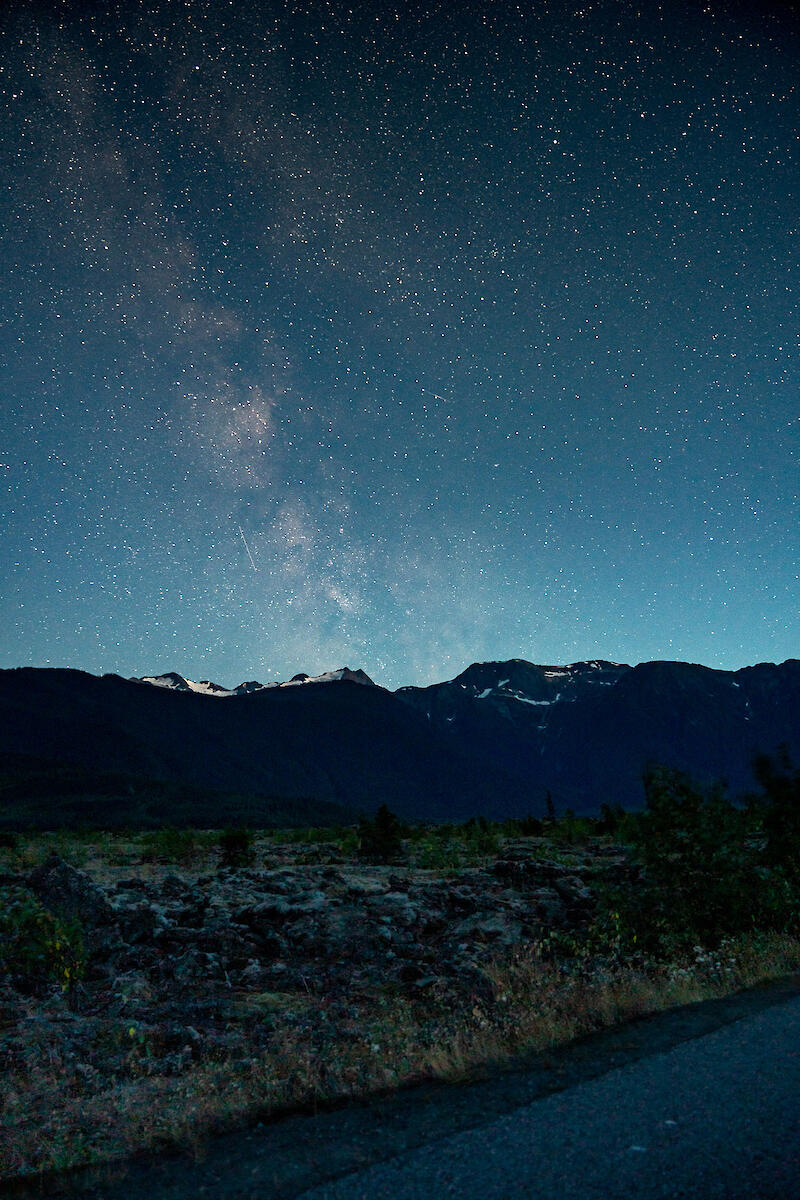
In an effort to beat the heat, we make an attempt to get to the Gitwinksihlkw trails somewhat early. It’s difficult to not be turned off by the initial climb up Leaping Lizard, but I soon realize that it’s not a sign of what’s to come. After that initial quick pitch, the grade smooths out considerably. The rest of the climb is painless and by the time we reach the downhill section we are pumped. Our bikes whip down the trail, each corner transitioning to another perfectly sculpted section.
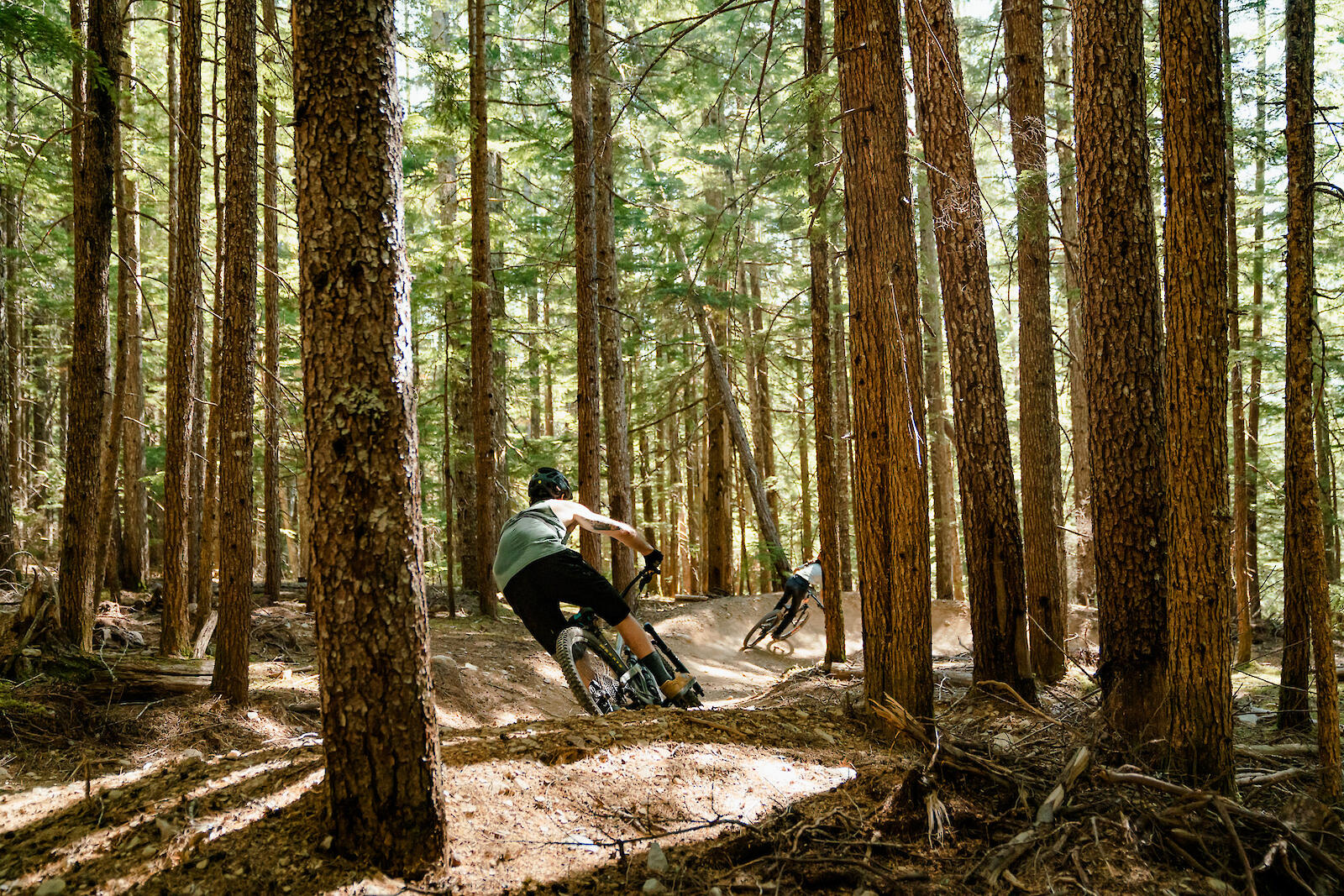
Arriving back at the truck, Kyle and I “hum & hah” but in the end, we decide that there is no way we can leave without doing the quick ride to the viewpoint. Perhaps it’s the 30+ degree weather but despite it being a smooth green, my body is opposing this pedal up the Saasak’ Hill Climb. Finally, we turn the last corner and step out onto the viewing platform overlooking the valley. Suddenly, every bead of sweat is worth it. I almost can’t believe the expanse of the volcano and the path it had carved when it originally ripped through the valley. Though fully exposed, I forget about the heat while taking in the views. The blue trail back to the parking is such fun, distracting me from the thirst slowly creeping up my throat.
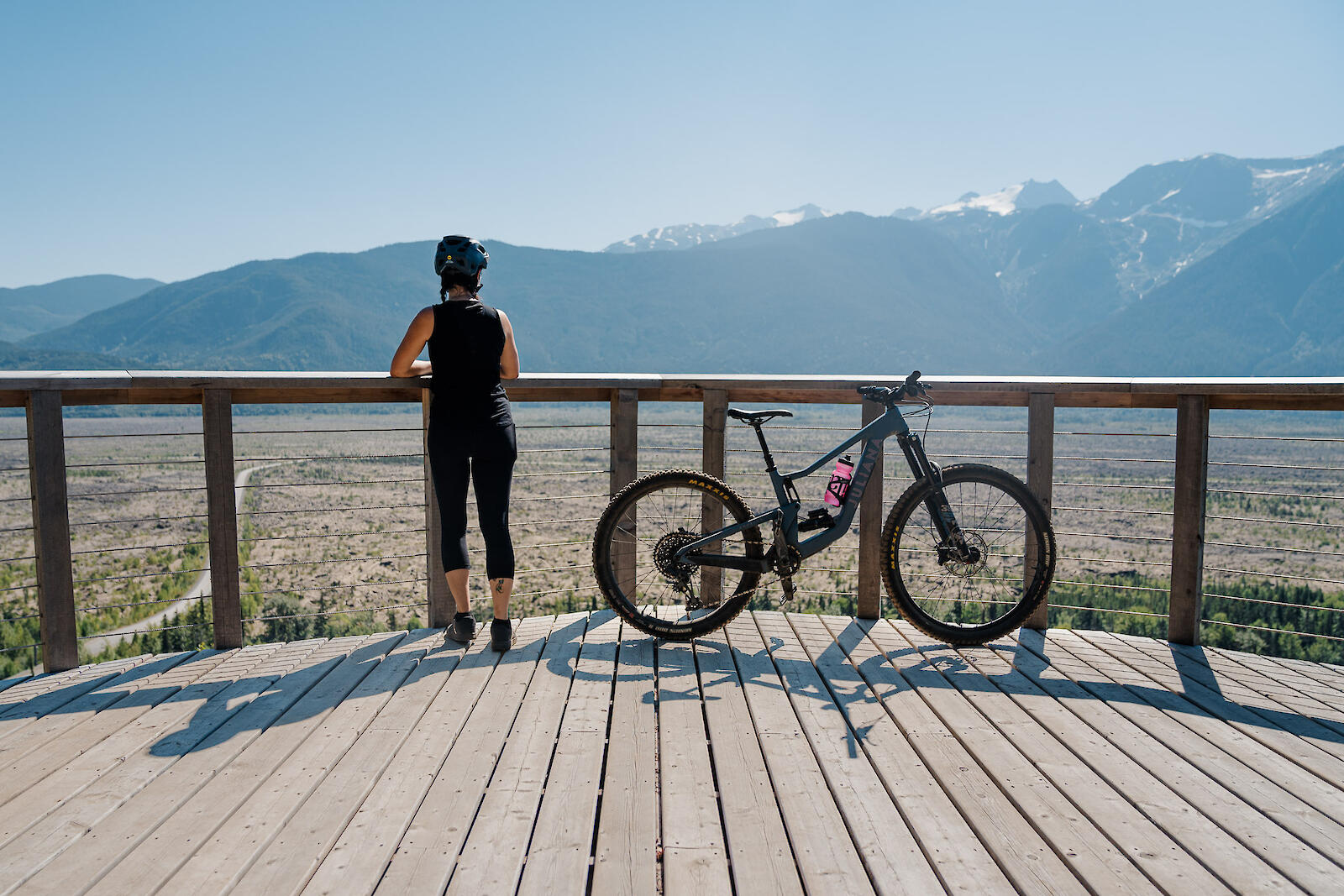
For so many years, the colonization of Canada tried to make Indigenous peoples fear their culture. Thankfully, so many resisted and practiced their customs in secret, whispering their languages to their children. As a result, ancient wisdom was preserved. I feel honoured to have been invited to learn alongside various Indigenous people and to be permitted to utilise the land for recreational purposes.
As a non-Indigenous Canadian citizen, it is up to me to take the initiative when it comes to reconciliation. Finding myself in these remote villages, I can’t help but feel that bike trails are a place for healing. They are a place where we can develop skills together, create friendships, connect with the land, and bridge the gap of understanding. They are a deeply spiritual place that inspire us to care for the land that surrounds us and remind us to pay respect to the original caretakers.
A huge thanks goes out to the Indigenous Youth Mountain Bike Program which is sparking a love for biking within Indigenous communities. A further thanks goes to the Indigenous communities that are building recreational opportunities for all to enjoy. These trails are drawing the attention of riders, forming connections, and creating new allies along the way.
---
We respectfully acknowledge and appreciate the opportunity to recreate on the traditional territory of the Stswecem’c Xgat’tem First Nation, Secwepmc First Nation, Xatśūll First Nation, Gitxsan First Nation and the Nisga’a lands.
